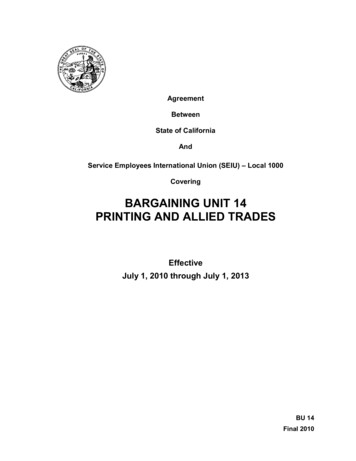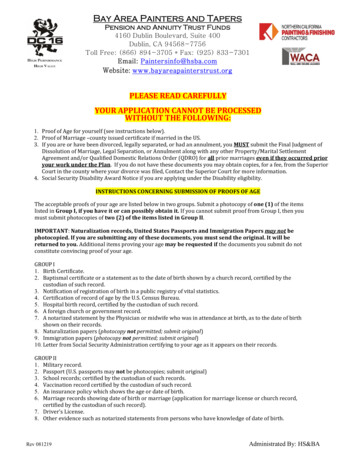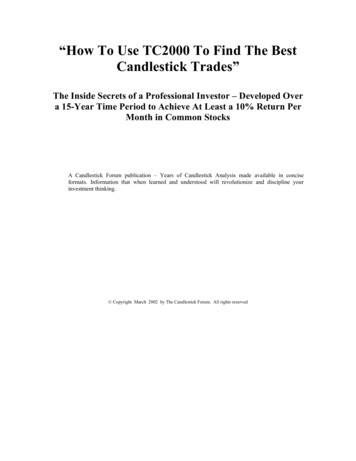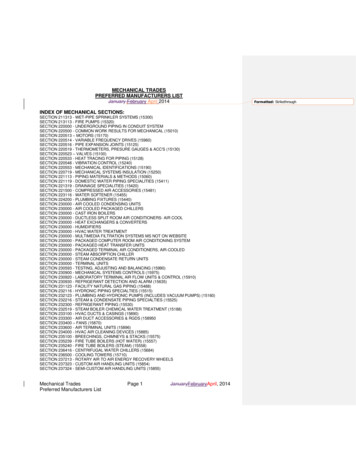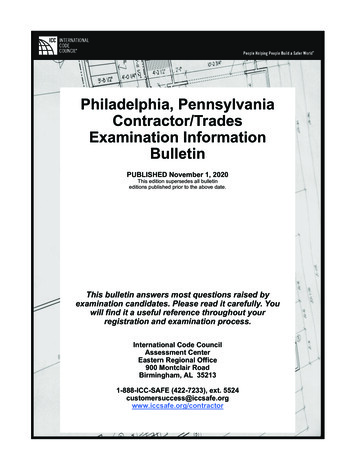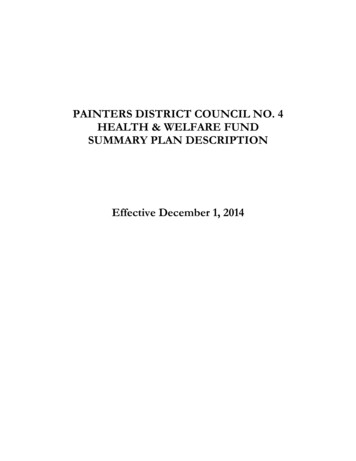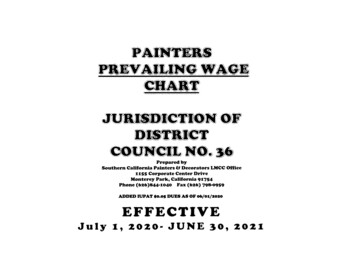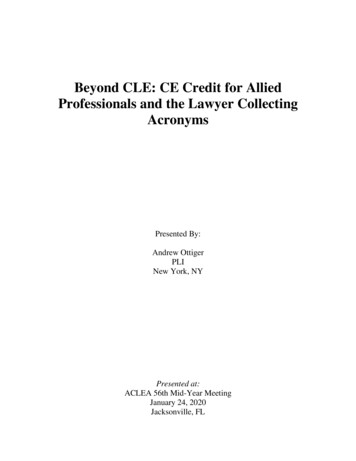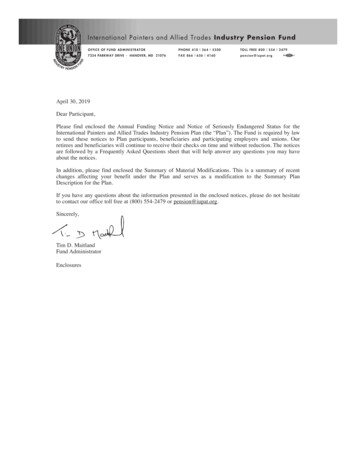
Transcription
2019 Notice Layout 1 4/18/19 2:31 PM Page 1International Painters and Allied Trades Industry Pension FundOFFICE OF FUND ADMINISTRATORPHONE 410 l 564 l 5500TOLL FREE 800 l 554 l 24797234 PARKWAY DRIVE U Ê HANOVER, MD 21076FAX 866 l 656 l 4160pension@iupat.orgApril 30, 2019Dear Participant,Please find enclosed the Annual Funding Notice and Notice of Seriously Endangered Status for theInternational Painters and Allied Trades Industry Pension Plan (the “Plan”). The Fund is required by lawto send these notices to Plan participants, beneficiaries and participating employers and unions. Ourretirees and beneficiaries will continue to receive their checks on time and without reduction. The noticesare followed by a Frequently Asked Questions sheet that will help answer any questions you may haveabout the notices.In addition, please find enclosed the Summary of Material Modifications. This is a summary of recentchanges affecting your benefit under the Plan and serves as a modification to the Summary PlanDescription for the Plan.If you have any questions about the information presented in the enclosed notices, please do not hesitateto contact our office toll free at (800) 554-2479 or pension@iupat.org.Sincerely,Tim D. MaitlandFund AdministratorEnclosures
2019 Notice Layout 1 4/18/19 2:31 PM Page 22
2019 Notice Layout 1 4/18/19 2:31 PM Page 3International Painters and Allied Trades Industry Pension FundOFFICE OF FUND ADMINISTRATORPHONE 410 l 564 l 5500TOLL FREE 800 l 554 l 24797234 PARKWAY DRIVE U Ê HANOVER, MD 21076FAX 866 l 656 l 4160pension@iupat.orgNotice of Seriously Endangered StatusInternational Painters & Allied Trades Industry Pension PlanEIN: 52-6073909 / PN: 001April 2019Under the requirements of the Pension Protection Act (“PPA”) of 2006, this is to inform you that, on March 29, 2019,the Plan actuary certified to the U.S. Department of the Treasury, and also to the Plan sponsor, that the InternationalPainters & Allied Trades Industry Pension Plan (the “Plan”) falls in the category of “seriously endangered status” forthe Plan Year beginning January 1, 2019. Federal law requires that you receive this notice.Seriously Endangered Status. The Plan is considered to be in “seriously endangered status” under the PPA becausethe Plan’s actuary has determined that the Plan’s funded percentage for 2019 is less than 80% and is projected to havean accumulated funding deficiency within 7 years.Funding Improvement Plan. In accordance with Federal law, the Trustees have adopted a funding improvement plan(“FIP”) aimed at improving the funded status of the plan so that the Plan may meet the applicable benchmarksestablished by PPA. The FIP went into effect on January 1, 2012 and was updated in 2017. A summary of the 2012FIP is on the Plan’s website and the update is available from the Fund Office. The Trustees of the Plan, with theassistance of its attorneys and actuaries, will monitor the progress of the Plan’s funding each year to determinewhether the requirements of the PPA are met.Contribution Limitations. After a certification that the Plan is in endangered or seriously endangered status, the Plancould not accept a collective bargaining or related agreement that provides for a reduction in future contribution rates,a suspension of contributions, or exclusion of new hires. The rejection of an agreement may cause a withdrawal andthe imposition of withdrawal liability. After the adoption of the FIP, the Plan cannot accept contributions that areinconsistent with the FIP and can impose the default schedule or withdrawal liability in the absence of timelycompliance with the FIP. If an employer does not pay contributions to the plan in accordance with the FIP, anemployer may also be liable for an excise tax equal to the amount of the shortfall in contributions.Benefit Limitations. After a certification that the Plan is in endangered or seriously endangered status, the Plan alsocould not, directly or indirectly, increase benefits by improving benefits, changes in the accrual of benefits, or anychange in the rate at which benefits become vested. Once the FIP took effect in 2012, the plan can only be amendedto increase benefits if the Plan actuary certifies that the benefit increases are consistent with the FIP and can be paidfor out of contributions not required by the FIP.Where to Get More Information. For more information about this Notice, you may contact the Fund Administrator,Tim Maitland at 410-564-5500, pension@iupat.org or 7234 Parkway Drive, Hanover, MD 21076. You have a right toreceive a copy of the FIP from the Plan.3
2019 Notice Layout 1 4/18/19 2:31 PM Page 4International Painters and Allied Trades Industry Pension FundOFFICE OF FUND ADMINISTRATORPHONE 410 l 564 l 5500TOLL FREE 800 l 554 l 24797234 PARKWAY DRIVE U Ê HANOVER, MD 21076FAX 866 l 656 l 4160pension@iupat.orgAnnual Funding NoticeInternational Painters & Allied Trades Industry Pension PlanApril 2019IntroductionThis notice includes important information about the funding status of your multiemployer pension plan, theInternational Painters & Allied Trades Industry Pension Plan (the “Plan”). It also includes general information aboutthe benefit payments guaranteed by the Pension Benefit Guaranty Corporation (“PBGC”), a federal insurance agency.All traditional pension plans (called “defined benefit pension plans”) must provide this notice every year regardlessof their funding status. This notice does not mean that the Plan is terminating. It is provided for informational purposesand you are not required to respond in any way. This notice is required by federal law. This notice is for the plan yearbeginning 1/1/2018 and ending 12/31/2018 (“Plan Year”)How Well Funded Is Your PlanThe law requires the administrator of the Plan to disclose how well the Plan is funded by using a measure called the“funded percentage.” The Plan divides the plan’s assets by its liabilities on the Valuation Date for the plan year to getthis percentage. In general, the higher the percentage, the better funded the plan. The Plan’s funded percentage for thePlan Year and each of the two preceding plan years is shown in the chart below. The chart also states the value of thePlan’s assets and liabilities for the same period.Plan Year (Jan 1-Dec. 31)Valuation DateFunded PercentageValue of AssetsValue of LiabilitiesFunded Percentage2018 Plan Year2017 Plan Year2016 Plan Year61.9%62.2%63.7%January 1, 2018January 1, 2017 3,326,181,666 3,269,554,532 5,377,511,693 5,254,701,262Year-End Fair Market Value of AssetsJanuary 1, 2016 3,261,440,053 5,120,010,317The asset values in the chart above are measured as of the Valuation Date. They also are “actuarial values.”Actuarial values differ from market values in that they do not fluctuate daily based on changes in the stock or othermarkets. Actuarial values smooth out those fluctuations and can allow for more predictable levels of futurecontributions. Despite the fluctuations, market values tend to show a clearer picture of a plan’s funded status at agiven point in time.4
2019 Notice Layout 1 4/18/19 2:31 PM Page 5The asset values in the chart below are market values and are measured on the last day of the Plan Year. The chartalso includes the year-end market value of the Plan’s assets for each of the three preceding plan years.Fair Market Value of Assets12/31/2018 3,196,000,000**Estimated. Final audited information was not available.12/31/2017 3,378,001,33612/31/2016 3,063,064,63012/31/2015 2,965,025,426Endangered, Critical, or Critical and Declining StatusUnder federal pension law, a plan generally is in “endangered” status if its funded percentage is less than 80 percent.A plan is in “critical” status if the funded percentage is less than 65 percent (other factors may also apply). A plan isin “critical and declining” status if it is in critical status and is projected to become insolvent (run out of money to paybenefits) within 15 years (or within 20 years if a special rule applies). If a pension plan enters endangered status, thetrustees of the plan are required to adopt a funding improvement plan. Similarly, if a pension plan enters critical statusor critical and declining status, the trustees of the plan are required to adopt a rehabilitation plan. Fundingimprovement and rehabilitation plans establish steps and benchmarks for pension plans to improve their funding statusover a specified period of time. The plan sponsor of a plan in critical and declining status may apply for approval toamend the plan to reduce current and future payment obligations to participants and beneficiaries.The Plan was in seriously endangered status in the Plan Year ending December 31, 2018 because the Plan’s fundedpercentage for 2018 was less than 80% and was projected to have a funding deficiency within 6 years.In an effort to improve the Plan’s funding situation, the trustees adopted a funding improvement plan (FIP) on April2, 2009 which is effective from January 1, 2012 through December 31, 2026 or until the Plan is no longer in seriouslyendangered or endangered status.The 2012 FIP provided two options. Under Option 1, the bargaining parties could increase their contribution rate by35% of the rate in effect at March 1, 2009 and participants would continue to accrue benefits. Option 2 was the defaultoption if the bargaining parties did not agree within 180 days of the expiration of a collective bargaining agreementin effect on January 1, 2009. Under the default schedule, an employer still had to increase the contribution rate by15% of the rate in effect at March 1, 2009, but retirement benefits were frozen at their level on December 31, 2011and were not increased for work with an employer contributing under Option 2 after 2011.The Trustees also adjusted benefit accrual rates in conjunction with the FIP. After 2011, new pension benefits onlyaccrue if an employer is “FIP Compliant” by contributing 135% or more of its March 2009 rate under Option 1. Foremployees of “FIP Compliant” employers, benefits accrue at one-half percent (0.5%) up to the contribution rate atJanuary 1, 2006 and one percent (1%) on amounts over the 2006 rate up to the March 2009 rate (and any contributionover 135% of the March 2009 rate). After 2011, the supplemental 35% contribution does not provide any additionalbenefit for any participant, as it is earmarked to improve the Plan’s funding. Beginning January 1, 2013, contributionsover the 135% benchmark will accrue benefits at 2% of the amount contributed over the 135% FIP Compliant Rate.The FIP was updated in 2017 to require employers to increase their FIP Compliant Rate by 50% on or beforeDecember 31, 2021. In other words, the rate as of December 31, 2021 must be equal to or greater than 150% x 135%x March 1, 2009 rate. For example, if the March 1, 2009 rate was 1.00 per hour, the rate in 2012 became 1.35 perhour and must reach 2.03 per hour by 2022. The 50% increase is capped at 4.00 per hour.You may get a copy of the Plan’s funding improvement plan, any update to such plan and the actuarial and financialdata that demonstrate any action taken by the Plan toward fiscal improvement by contacting the Fund Administratorat the address at the end of this notice. If the Plan is in endangered, critical or critical and declining status for the planyear ending December 31, 2019, separate notification of that status has or will be provided.Participant InformationThe total number of participants and beneficiaries covered by the Plan on the valuation date was 84,550. Of thisnumber, 36,758 were current employees, 29,794 were retired and receiving benefits, and 17,998 were no longerworking for the employers and have a right to future benefits.5
2019 Notice Layout 1 4/18/19 2:31 PM Page 6Funding & Investment PoliciesEvery pension plan must have a procedure to establish a funding policy for plan objectives. A funding policy relatesto how much money is needed to pay promised benefits. The funding policy of the Plan is to set benefits based onexpected contributions made pursuant to collective bargaining agreements in effect and to modify requiredcontributions when necessary to maintain or improve the plan’s funding level.Pension plans also have investment policies. These generally are written guidelines or general instructions for makinginvestment management decisions. The investment policy of the Plan is that the investments are to be managed withthe primary focus being preservation of capital. Emphasis will be placed on participation with the fixed income, equityand alternatives in line with broad market averages during times of rising markets and preservation of capital duringperiods of market contraction. Additionally, it is the Plan’s desire to earn total returns (income plus capital gains) inexcess of major indices of each asset class over a typical market cycle by utilizing the services of investment managers.Under the plan’s investment policy, assets were allocated among the following categories of investments, as of theend of the Plan Year. These allocations are percentages of total assets:Asset Allocations1. Cash (Interest bearing and non-interest bearing)2. U.S. Government securities3. Corporate debt instruments (other than employer securities):PreferredAll other4. Corporate stocks (other than employer securities):PreferredCommon5. Partnership/joint venture interests6. Real estate (other than employer real property)7. Loans (other than to participants)8. Participant loans9. Value of interest in common/collective trusts10. Value of interest in pooled separate accounts11. Value of interest in 103-12 investment entities12. Value of interest in master trust investment accounts13. Value of interest in registered investment companies (e.g., mutual funds)14. Value of funds held in insurance co. general account (unallocated contracts)15. Employer-related investments:Employer SecuritiesEmployer real property16. Buildings and other property used in plan operation17. OtherRight to Request a Copy of the Annual ension plans must file annual reports with the US Department of Labor. The report is called the “Form 5500.” Thesereports contain financial and other information. You may obtain an electronic copy of your Plan’s annual report bygoing to www.efast.dol.gov and using the search tool. Annual reports also are available from the US Department ofLabor, Employee Benefits Security Administration’s Public Disclosure Room at 200 Constitution Avenue, NW, RoomN1513, Washington, DC 20210, or by calling 202.693.8673. You may obtain a copy of the Plan’s annual report bymaking a written request to the Fund Administrator or obtain the basic Form 5500 and certain schedules from the Plan’swebsite at https://iupat.org/wp-content/uploads/Form-5500.pdf Annual reports do not contain personal information,such as the amount of your accrued benefit. You may contact your plan administrator if you want information aboutyour accrued benefits. Your plan administrator is identified below under “Where To Get More Information.”6
2019 Notice Layout 1 4/18/19 2:31 PM Page 7Summary of Rules Governing Insolvent PlansFederal law has a number of special rules that apply to financially troubled multiemployer plans that becomeinsolvent, either as ongoing plans or plans terminated by mass withdrawal. The plan administrator is required by lawto include a summary of these rules in the annual funding notice. A plan is insolvent for a plan year if its availablefinancial resources are not sufficient to pay benefits when due for that plan year. An insolvent plan must reduce benefitpayments to the highest level that can be paid from the plan’s available resources. If such resources are not enough topay benefits at the level specified by law (see Benefit Payments Guaranteed by the PBGC, below), the plan must applyto the PBGC for financial assistance. The PBGC will loan the plan the amount necessary to pay benefits at theguaranteed level. Reduced benefits may be restored if the plan’s financial condition improves.A plan that becomes insolvent must provide prompt notice of its status to participants and beneficiaries, contributingemployers, labor unions representing participants, and PBGC. In addition, participants and beneficiaries also mustreceive information regarding whether, and how, their benefits will be reduced or affected, including loss of a lumpsum option.Benefit Payments Guaranteed by the PBGCThe maximum benefit that the PBGC guarantees is set by law. Only benefits that you have earned a right to receiveand that cannot be forfeited (called vested benefits) are guaranteed. There are separate insurance programs withdifferent benefit guarantees and other provisions for single-employer plans and multiemployer plans. Your Plan iscovered by PBGC’s multiemployer program. Specifically, the PBGC guarantees a monthly benefit payment equal to100 percent of the first 11 of the Plan’s monthly benefit accrual rate, plus 75 percent of the next 33 of the accrualrate, times each year of credited service. The PBGC’s maximum guarantee, therefore, is 35.75 per month times aparticipant’s years of credited service.Example 1: If a participant with 10 years of credited service has an accrued monthly benefit of 600, the accrual ratefor purposes of determining the PBGC guarantee would be determined by dividing the monthly benefit by theparticipant’s years of service ( 600/10), which equals 60. The guaranteed amount for a 60 monthly accrual rate isequal to the sum of 11 plus 24.75 (.75 x 33), or 35.75. Thus, the participant’s guaranteed monthly benefit is 357.50 ( 35.75 x 10).Example 2: If the participant in Example 1 has an accrued monthly benefit of 200, the accrual rate for purposes ofdetermining the guarantee would be 20 (or 200/10). The guaranteed amount for a 20 monthly accrual rate is equalto the sum of 11 plus 6.75 (.75 x 9), or 17.75. Thus, the participant’s guaranteed monthly benefit would be 177.50 ( 17.75 x 10).The PBGC guarantees pension benefits payable at normal retirement age and some early retirement benefits. Inaddition, the PBGC guarantees qualified preretirement survivor benefits (which are preretirement death benefitspayable to the surviving spouse of a participant who dies before starting to receive benefit payments). In calculatinga person’s monthly payment, the PBGC will disregard any benefit increases that were made under the plan within 60months before the earlier of the plan’s termination or insolvency (or benefits that were in effect for less than 60 monthsat the time of termination or insolvency). Similarly, the PBGC does not guarantee benefits above the normalretirement benefit, disability benefits not in pay status, or non-pension benefits, such as health insurance, lifeinsurance, death benefits, vacation pay, or severance pay.For additional information about the PBGC and the pension insurance program guarantees, go to the MultiemployerPage on PBGC’s website at acts Please contact the FundAdministrator for specific information about your pension plan or pension benefit. PBGC does not have thatinformation. See “Where to Get More Information About Your Plan,” below.Where to Get More InformationFor more information about this notice, you may contact Tim Maitland, Fund Administrator, at 7234 Parkway Drive,Hanover, MD 21076, 410-564-5500, pension@iupat.org. For identification purposes, the official plan number is 001and the plan sponsor’s name and employer identification number or “EIN” is 52-6073909.Issued: April 20197
FAQs and SSM Layout 1 4/19/19 7:25 AM Page 1ANNUAL FUNDING NOTICE FAQWhy am I getting this information?The Fund is required by law to send these notices to all Plan participants, beneficiaries and participating employersregardless of the Fund status. You will receive this notice every year with
International Painters and Allied Trades Industry Pension Fund OFFICE OF FUND ADMINISTRATOR PHONE 410 l 564 l 5500 TOLL FREE 800 l 554 l 2479 7234 PARKWAY DRIVE UÊHANOVER, MD 21076 FAX 866 l 656


